Oral cancer
Oral cancer accounts for roughly two percent of all cancers diagnosed annually. Unfortunately approximately 36,500 people will be diagnosed with oral cancer each year and about 7,900 will die from the disease. On average, 61 percent of those with the disease will survive more than 5 years.
The Importance of Early Detection
Early Detection Saves Lives, with early detection and timely treatment, deaths from oral cancer could be dramatically reduced. The 5-year survival rate for those with localised disease at diagnosis is 83 percent compared with only 32 percent for those whose cancer has spread to other parts of the body. Early detection of oral cancer is often possible. Tissue changes in the mouth that might signal the beginnings of cancer often can be seen and felt easily.
Warning Signs
Two lesions that could be precursors to cancer are white lesions and red lesions. Any white or red lesion that does not resolve itself in 2 weeks should be re-evaluated and considered for biopsy to obtain a definitive diagnosis.
Other possible signs and symptoms of oral cancer that you may report include: a lump or thickening in the mouth, soreness or a feeling that something is caught in the throat, difficulty chewing or swallowing, ear pain, difficulty moving the jaw or tongue, numbness of the tongue or other areas of the mouth, or swelling of the jaw that causes dentures to fit poorly or become uncomfortable.
If these problems persist for more than 2 weeks, a thorough clinical examination and laboratory tests should be required this is to be performed to obtain a definitive diagnosis. If a diagnosis cannot be obtained, referral to the appropriate specialist with be arranged.
Risk Factors
- Tobacco/Alcohol Use: Most cases of oral cancer are linked to cigarette smoking, heavy alcohol use, or the use of both tobacco and alcohol together. Using tobacco plus alcohol poses a much greater risk than using either substance alone.
- HPV: Infection with the sexually transmitted human papillomavirus (specifically the HPV 16 type) has been linked to a subset of oral cancers.
- Age: Risk increases with age. Oral cancer most often occurs in people over the age of 40.
- Sun Exposure: Cancer of the lip can be caused by sun exposure.
- Diet: A diet low in fruits and vegetables may play a role in oral cancer development.
What You Can Do
- A thorough head and neck examination should be a routine part of each patient’s dental visit and general medical examination. Clinicians should be particularly vigilant in checking those who use tobacco or excessive amounts of alcohol.
- A history of your alcohol and tobacco use will be taken.
- Information on association between tobacco use, alcohol use, and oral cancer will be explained.
- Follow-up to make sure a definitive diagnosis is obtained on any possible signs or symptoms of oral cancer.


